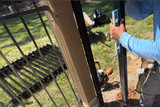Plumb vs. Level: Understanding the Difference in Fence Post Installation
When it comes to installing a fence, getting the job done right the first time is crucial. One of the key aspects of a successful fence installation is ensuring that your fence posts are both plumb and level. While these terms may sound similar, they have distinct meanings and serve different purposes in the construction process. In this blog post, we will delve into the difference between plumb and level and why both are essential for a sturdy and visually appealing fence.
- Plumb: Perfectly Vertical
To understand the concept of plumb, think of it as a way to describe an object's position in a perfectly vertical orientation, like a well-built wall or, in this case, a fence post. Plumbness refers to the up-and-down alignment of an object. When a fence post is plumb, it means it is standing perfectly straight up and down, without leaning to either side.
Why Plumbness Matters:
a. Stability: Plumb fence posts ensure the structural stability of your fence. They can better withstand external forces like wind, rain, and even accidental impacts.
b. Aesthetics: A plumb fence post enhances the overall appearance of your fence. It looks clean and uniform, which contributes to the visual appeal of your property.
c. Easy Alignment: Plumb posts make it easier to align the fence rails and panels correctly, resulting in a more professional and polished finish.
- Level: Evenly Horizontal
While plumb addresses the vertical alignment, "level" deals with the horizontal orientation. A level fence post means that the top of the post is completely parallel to the ground. In other words, it doesn't slope upward or downward from one end to the other.
Why Level Matters:
a. Consistency: Level fence posts ensure that the top of your fence is consistently straight, giving it a polished and professional appearance.
b. Prevents Water Accumulation: A level fence post helps water drain away properly and prevents it from pooling at the base of the post, which can lead to rot and decay with wooden posts.
c. Easier Fence Panel Installation: A level fence post makes it easier to attach fence panels, ensuring they fit securely and evenly.
How to Achieve Both Plumb and Level Fence Posts
- Start with Proper Foundations: Ensure that your fence posts have a solid foundation, typically a concrete footing. This provides stability and prevents the posts from sinking or shifting over time.
- Use a Level and a Plumb Bob: Invest in the right tools to help you achieve both plumb and level. A level helps you maintain the horizontal orientation, while a plumb bob or a level with plumb vials helps ensure the posts are vertically straight.
- Regularly Check and Adjust: As you install each post, continually check for plumb and level. Adjust as necessary before the concrete sets to avoid future complications.
To build a fence that is both sturdy and visually pleasing, it's crucial to understand and apply the concepts of plumb and level during installation. Plumb ensures your fence posts are perfectly vertical, while level ensures they are horizontally even. By achieving both plumb and level, you'll have a fence that not only stands strong against the elements but also enhances the overall aesthetics of your property. So, next time you embark on a fence installation project, remember the importance of achieving both plumb and level posts for a job well done.
Recent Posts
-
Experience, Reputation, Customer Service
Here’s why buying from OnlineFenceStore.com is a strong choice for fencing products: Key Advantages …Aug 13th 2025 -
How to Order Fence from OnlineFenceStore.com: A Step-by-Step Guide
How to Order Fence from OnlineFenceStore.com: A Step-by-Step Guide Ordering a fence online has never …Jul 30th 2025 -
Plumb vs. Level: Understanding the Difference in Fence Post Installation
When it comes to installing a fence, getting the job done right the first time is crucial. One of th …Jun 19th 2025







